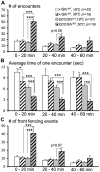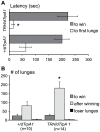Targeted manipulation of serotonergic neurotransmission affects the escalation of aggression in adult male Drosophila melanogaster
- PMID: 20520823
- PMCID: PMC2875409
- DOI: 10.1371/journal.pone.0010806
Targeted manipulation of serotonergic neurotransmission affects the escalation of aggression in adult male Drosophila melanogaster
Abstract
Dopamine (DA) and serotonin (5HT) are reported to serve important roles in aggression in a wide variety of animals. Previous investigations of 5HT function in adult Drosophila behavior have relied on pharmacological manipulations, or on combinations of genetic tools that simultaneously target both DA and 5HT neurons. Here, we generated a transgenic line that allows selective, direct manipulation of serotonergic neurons and asked whether DA and 5HT have separable effects on aggression. Quantitative morphological examination demonstrated that our newly generated tryptophan hydroxylase (TRH)-Gal4 driver line was highly selective for 5HT-containing neurons. This line was used in conjunction with already available Gal4 driver lines that target DA or both DA and 5HT neurons to acutely alter the function of aminergic systems. First, we showed that acute impairment of DA and 5HT neurotransmission using expression of a temperature sensitive form of dynamin completely abolished mid- and high-level aggression. These flies did not escalate fights beyond brief low-intensity interactions and therefore did not yield dominance relationships. We showed next that manipulation of either 5HT or DA neurotransmission failed to duplicate this phenotype. Selective disruption of 5HT neurotransmission yielded flies that fought, but with reduced ability to escalate fights, leading to fewer dominance relationships. Acute activation of 5HT neurons using temperature sensitive dTrpA1 channel expression, in contrast, resulted in flies that escalated fights faster and that fought at higher intensities. Finally, acute disruption of DA neurotransmission produced hyperactive flies that moved faster than controls, and rarely engaged in any social interactions. By separately manipulating 5HT- and DA- neuron systems, we collected evidence demonstrating a direct role for 5HT in the escalation of aggression in Drosophila.
Conflict of interest statement
Figures





References
Publication types
MeSH terms
Substances
Grants and funding
LinkOut - more resources
Full Text Sources
Other Literature Sources
Medical
Molecular Biology Databases

